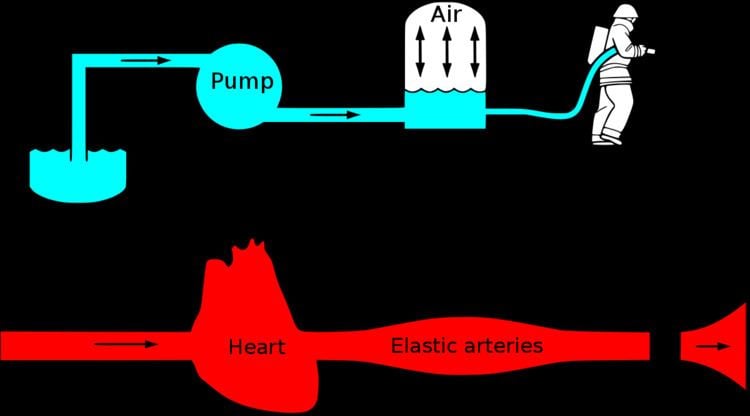 | ||
Windkessel effect is a term used in medicine to account for the shape of the arterial blood pressure waveform in terms of the interaction between the stroke volume and the compliance of the aorta and large elastic arteries (Windkessel vessels). Windkessel when loosely translated from German to English means 'air chamber', but is generally taken to imply an elastic reservoir. The walls of large elastic arteries (e.g. aorta, common carotid, subclavian, and pulmonary arteries and their larger branches) contain elastic fibers, formed of elastin. These arteries distend when the blood pressure rises during systole and recoil when the blood pressure falls during diastole. Since the rate of blood entering these elastic arteries exceeds that leaving them due to the peripheral resistance there is a net storage of blood during systole which discharges during diastole. The distensibility of the large elastic arteries is therefore analogous to a capacitor.
The Windkessel effect helps in damping the fluctuation in blood pressure (pulse pressure) over the cardiac cycle and assists in the maintenance of organ perfusion during diastole when cardiac ejection ceases. The idea of the Windkessel was alluded to by Giovanni Borelli, although Stephen Hales articulated the concept more clearly and drew the analogy with an air chamber used in fire engines in the 18th century. Otto Frank (physiologist), an influential German physiologist, developed the concept and provided a firm mathematical foundation. Frank's model is sometimes called a two-element Windkessel to distinguish it from more recent and more elaborate Windkessel models (e.g. three- or four-element Windkessels).
The Windkessel effect becomes diminished with age as the elastic arteries become less compliant, termed hardening of the arteries or arteriosclerosis, probably secondary to fragmentation and loss of elastin. The reduction in the Windkessel effect results in increased pulse pressure and elevated systolic pressure for a given stroke volume. Elevated systolic pressure (hypertension) predicts myocardial infarction, stroke, heart failure and a variety of other cardiovascular diseases.
Although the Windkessel is a simple and convenient concept, it is widely seen as in conflict with, and superseded by, modern approaches that interpret arterial pressure and flow waveforms in terms of wave propagation and reflection, although recently attempts have been made to integrate wave propagation and Windkessel approaches.
